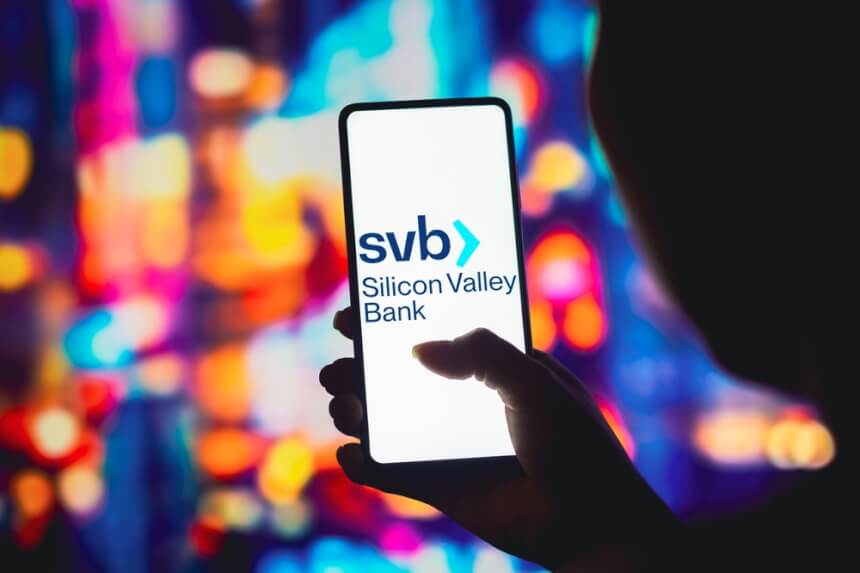Silicon Valley Bank may not be the only US bank facing liquidity problems, Gavekal said in a report this afternoon.
“There is a high risk that more problems will emerge at other banks,” the consultancy said.
Profits of US commercial banks “are under pressure from worsening asset quality, weak loan growth, falling reserves and rising interest rates on bank deposits,” says the international consultancy, for whom the SVB is just the first in a series of institutions in trouble.
The Silicon Valley “startup bank” did not resist the bleeding in its deposits and suffered intervention from the American government this afternoon, becoming the first major American financial institution to fail since Washington Mutual in the 2008 crisis.
SVB had been trying to raise capital since the beginning of the week, while talking to potential buyers of its operations. There was no time.
Its shares plunged 80% before trading was suspended.
The Federal Deposit Insurance Corporation (FDIC), the US agency created in 1933 at the height of the Great Depression to protect account holders and savers, took over.
Headquartered in Santa Clara, Calif., the 16th largest US bank by assets carried $175 billion in deposits.
The trigger that triggered the crisis came late Wednesday, when the bank surprised Wall Street by saying it had to sell a portfolio of bonds (at a loss of $1.8 billion) and was still planning to raise $2.25. billion with the sale of new shares, capital needed to strengthen its balance sheet.
The news started a race for rescues, from Vale to Faria Lima.
Yesterday, as CEO Greg Becker told customers to “keep calm,” Peter Thiel and other VCs called their lineups and ordered them to cash out—immediately.
The SVB crisis engulfed the financial sector in yesterday’s trading session, with the four largest US banks losing more than $50 billion in market value.
Once again, the reversal of a period of great financial liquidity will leave dead and wounded. The question is whether there is a risk of contagion similar to that of the subprime em 2008.
The times of extremely low interest rates inflated several businesses in the US, and venture capital surfed (a lot) this wave.
By early 2022, before the Federal Reserve began tightening money, there was a boom in funding for startups – and many of these tech companies are SVB customers.
As Gavekal points out, the results of commercial banks basically depend on two factors: the size of their balance sheets and the margins received on transactions, and “the scenario for both is dismal.”
Currency tightening has lowered the pace of lending, worsening asset quality, and defaults have risen. “This has reduced earnings from credit, which is particularly bad for smaller banks,” says Gavekal.
At the same time, savers began to seek more profitable alternatives in fixed income after years of interest rates close to zero. O yield of 2-year Treasuries was below 2% in March last year, and has now hit 5% – a return not seen since 2007.
For banks, it is not only the increase in interest rates that weighs, but also the quantitative tightening initiated by the Fed in 2019, starting the shrinking of its balance sheet after more than a decade of vertiginous expansion. Today, the American BC drains almost US$ 100 billion in liquidity from the financial system per month.
Smaller bank reserves have been hit hard. At the same time, those institutions in a more complicated capital situation delayed the increase in interest paid to account holders on deposits.
Consequence: customers went in search of better profitability in other institutions or even in Treasury bonds – and if the smaller banks increase the interest paid, they will have even smaller profits, aggravating the imbalances.
Despite the recent slight increase, the yield on deposit rates does not reach 2%, well below government bonds and even further below inflation.
“In short, US commercial banks entered 2023 facing a multiple squeeze on their earnings. The SVB sounded the alarm, drawing investors’ attention to the problem,” says Gavekal. “This is not a buy-the-dip opportunity. Portfolio managers must remain underweight in bank shares.
UBS, on the other hand, said it does not see (so far) “classic signs of contagion, such as stress in the banking market.”
But he says that SVB is not the only institution whose balance sheet has been impacted by the devaluation of assets, especially by the fall in the value of Treasuries parked in the capital reserves required by regulators.
Since the great international financial crisis, banks have been required to maintain a liquidity coverage ratio of more than 100% of their deposits, with liquid and high-quality assets – in general, these papers are largely government bonds.
According to the FDIC, US banks have unrealized losses of $620 billion. This is because, with high interest rates, the securities in their portfolios have lost value.
Banks are not obliged to mark these losses to market. But one day they come to light, as now in the case of SVB, when the bank is forced to sell the shares to honor the redemption requests.
For UBS, these “events reinforce our negative view for US financial stocks” and, in addition, “concerns about bank earnings and their balance sheets deepen the negative sentiment for the stock market as a whole.”
Giuliano Guandalini
